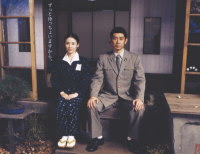The Blossoming of Etsuko Kamiya, Kazuo Kuroki’s final film before his death in 2006, is a quiet, gently humorous, and poignant World War II-set story that evokes the home dramas that were a specialty of Ozu. Based on a stage play by Masataka Matsuda, the film makes little attempt to disguise its theatrical origins. Its structure consists of several lengthy scenes of dialogue between different combinations of its main characters in two locations: a hospital rooftop in the present day, and the family house during wartime. This is to the film’s strength, since the strictly limited settings bring the characters’ emotions and the subtle variations of tone into sharper relief, making the film’s emotional conclusion that much more powerful.
Like many of Ozu’s films, the plot revolves around a prospective marriage, that of Etsuko Kamiya (Tomoyo Harada), who lives with her brother and his wife, having recently lost both her parents in an air raid. They are very protective of her and are anxious for her to marry. They have found her a possible husband, Nagayo (Masatoshi Nagase), an army engineer. However, Etsuko is truly in love with Nagayo’s friend Akashi (Shunsuke Matsuoka). A relationship between them is impossible since Akashi has been conscripted to be a kamikaze pilot. Akashi, also in love with Etsuko, but choosing military duty over love, has arranged for Nagayo to take his place.
As tragic as the situation is, the scenario finds much room for comedy, for example in the scene in which the painfully shy Nagayo has his marriage meeting with Etsuko, with Akashi at his side. He struggles to find topics for conversation, and can only come up with half-remembered names from literature, and a recitation of his life and work resume. Akashi eventually slips away, leaving the two of them alone. The bickering between Etsuko’s brother and his wife is also another rich source of humor, such as an initial scene when he angers his wife by commenting on the sour potatoes.
The film’s use of mirroring and repetition of details also adds interesting dimensions to the story. There are bracketed scenes in which Etsuko and later her brother are late getting home, both for the same reason: being held up by the talkative stationmaster. Both Akashi and Nagoya’s actions of walking up and down the stairs to the family home punctuate the most emotional points of the story. The story is itself framed by Etsuko and Nagayo’s wartime reminiscences on the hospital rooftop.
The war itself happens far from the film’s action, but determines everything that occurs. The film refrains from explicitly condemning the war, except in Etsuko’s sister-in-law’s anguished cry about not caring if Japan wins, only wanting things to return to normal, without rations and fear of being bombed. The others admonish her for saying such a thing, and the war is treated as a situation that must be dealt with stoically. However, the film’s implicit regret over wartime sacrifices seeps in, especially when Etsuko finally releases her grief over the news of Akashi’s death.
The Blossoming of Etsuko Kamiya is a simply told tale, but no less enjoyable for that. The film’s style is as simple and unassuming as the wartime rations the family eats. Such a film is almost entirely dependent on the actors’ performances, and there isn’t a single false note here. Harada and Nagase are especially fine, excelling at registering the subtle emotional shifts that lie below their seemingly placid surfaces.





